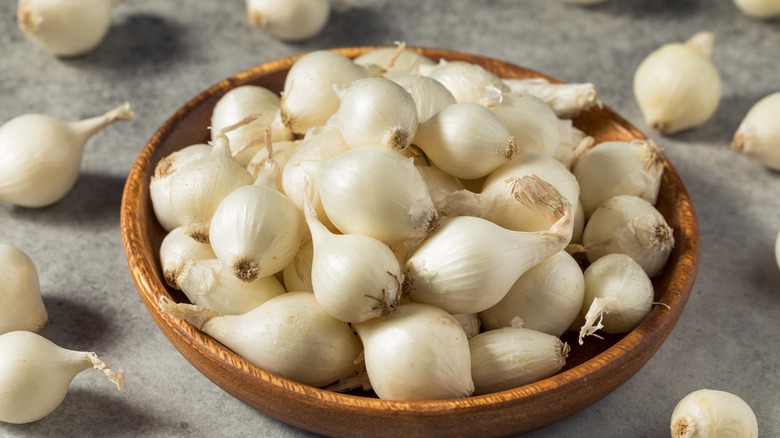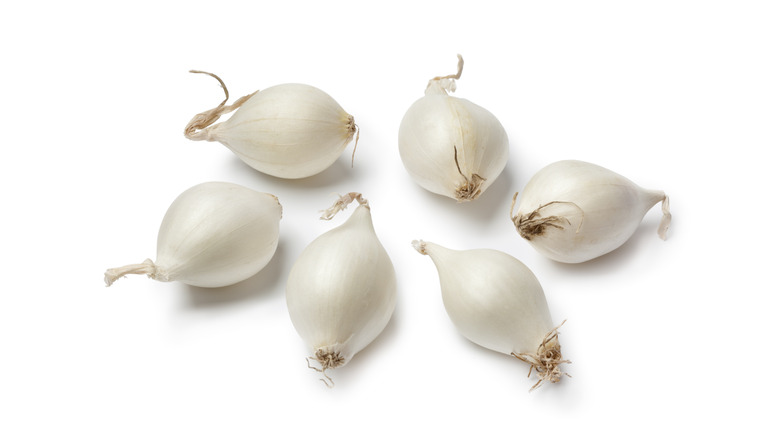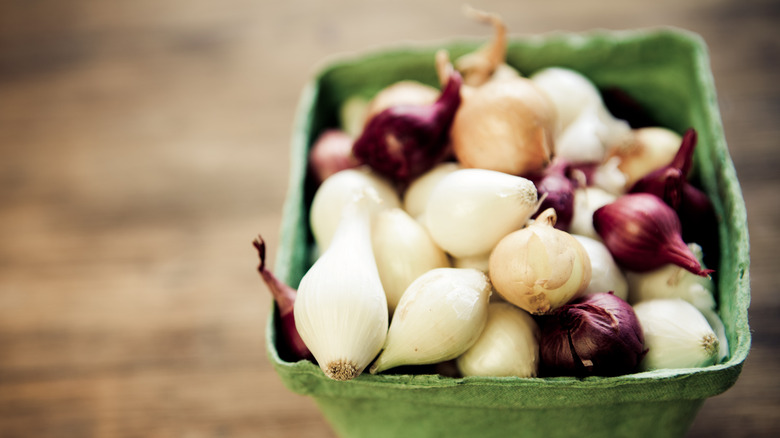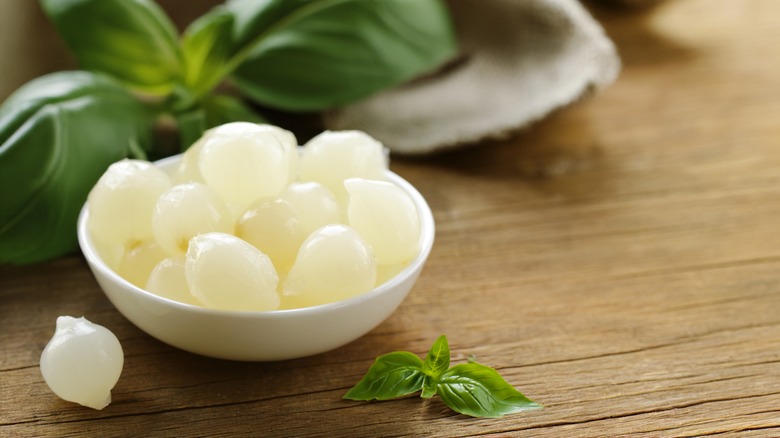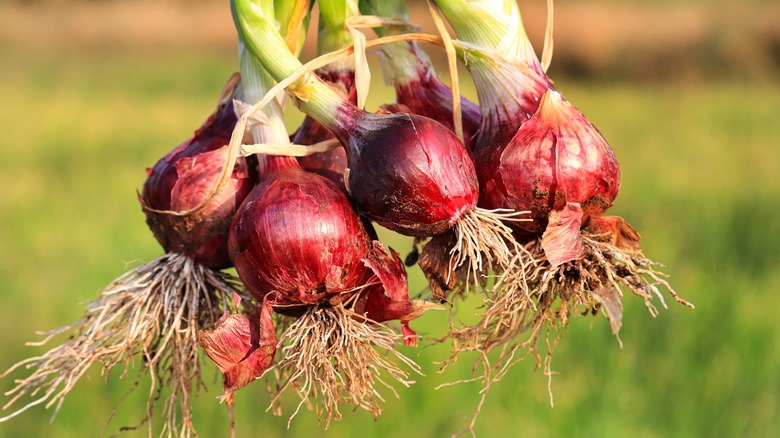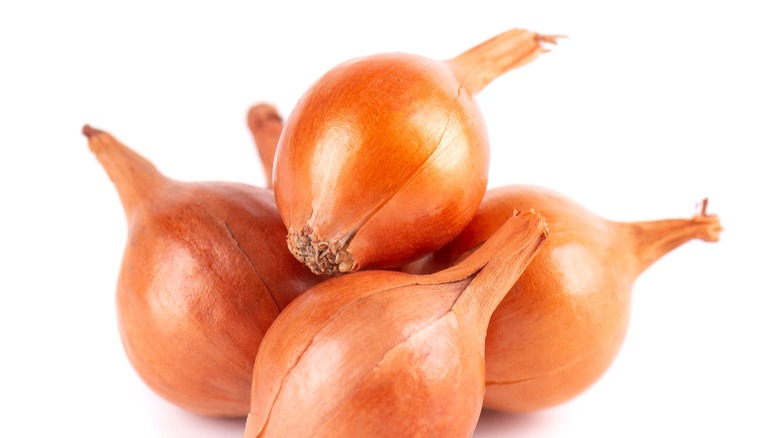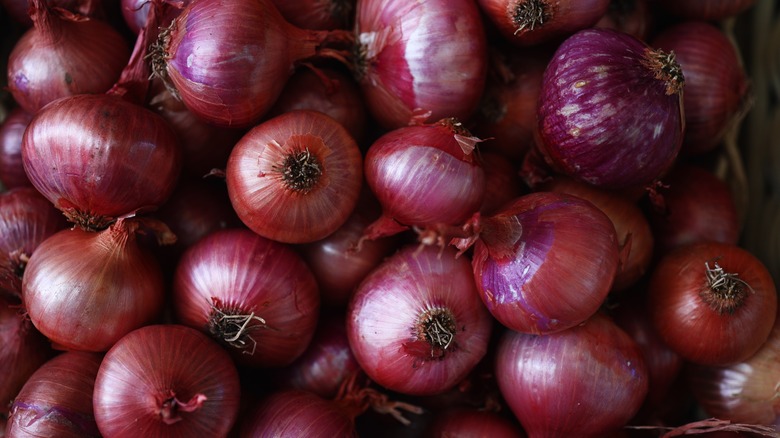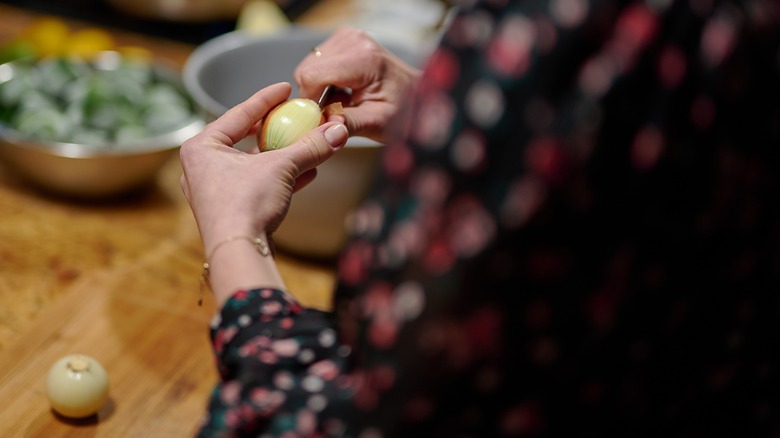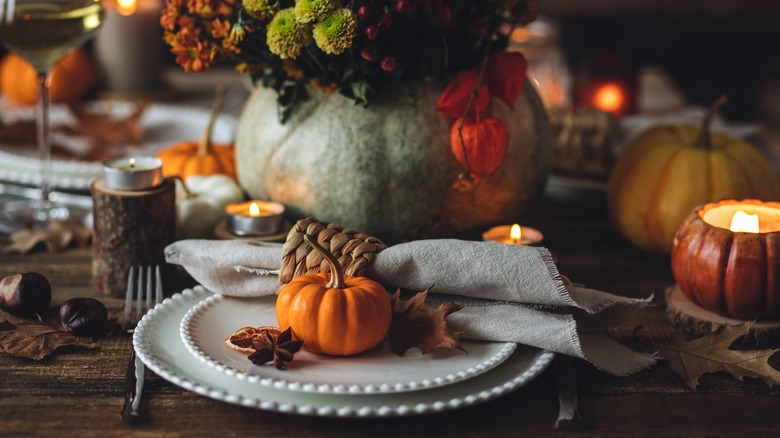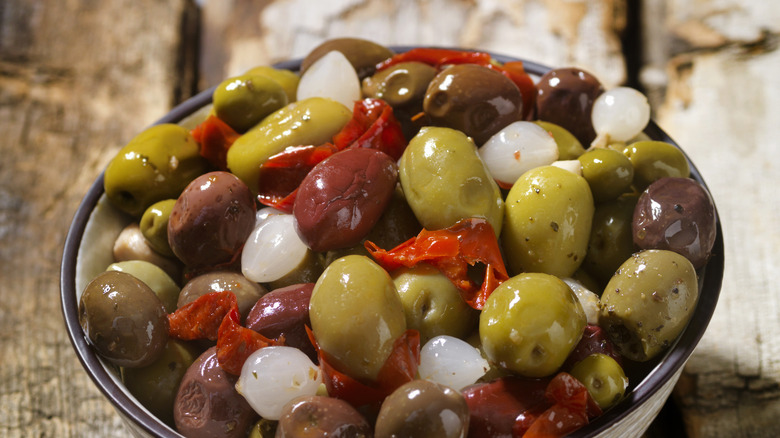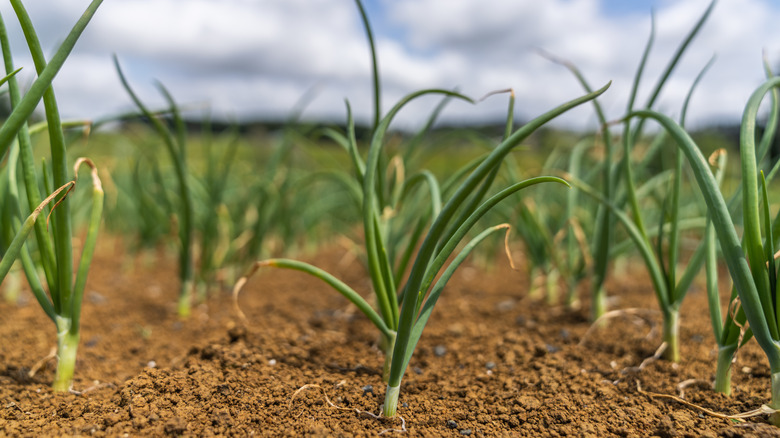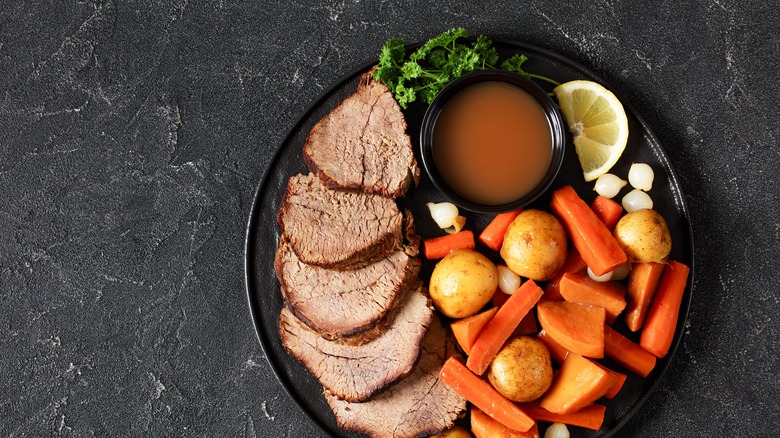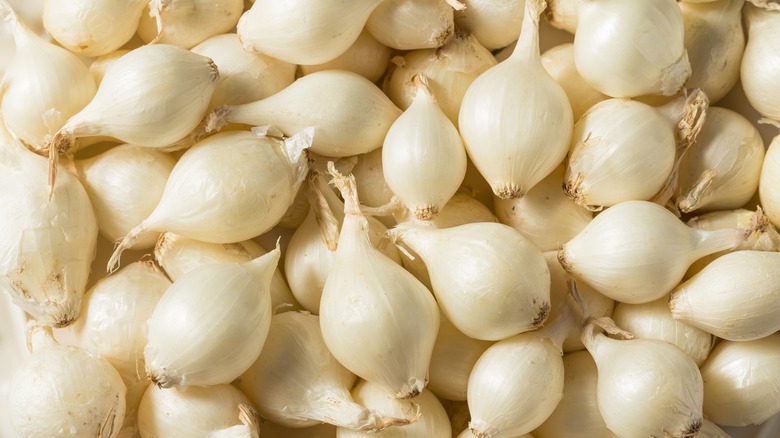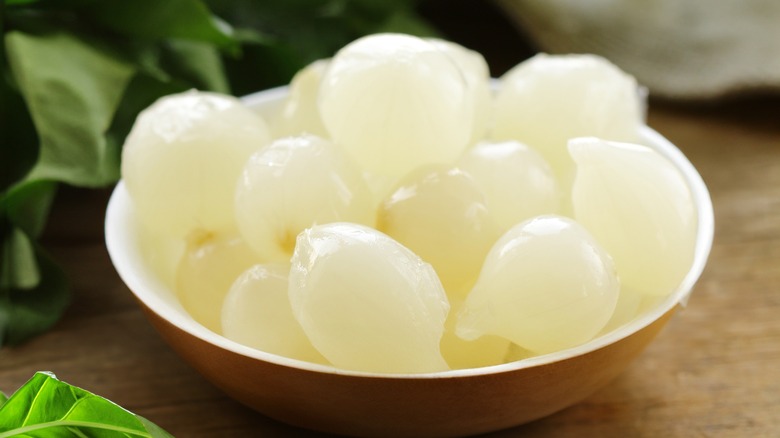What Are Pearl Onions And How Do You Cook With Them?
We may receive a commission on purchases made from links.
Pearl onions are delicious, plain and simple. Small, soft, and silky, they're tiny enough to eat whole. Their lovely texture and the slight burst in your mouth when you bite into them have made them a favorite at the holiday table, where you'll most commonly find them prepared as creamed onions, a classic New England dish. However, they're suitable for much more than that. Any home cook who is serious about winter fare should know how to buy, clean, prep, and cook them.
The thing you must realize about pearl onions, though, is that they are a lot of work. Many home chefs have let this deter them, missing out on the potential cuteness and flavor of pearl onions at the table. Instead of taking such a draconian approach, you should instead learn how to prep them in the easiest way that works for you. If you like the traditional method, you will learn it here, but there are also shortcuts to save you time.
What are pearl onions?
While bulb onions have been used for 5,000 years, pearl onions are a new innovation. Not that new, however. They have been around for more than 100 years at this point, first recorded between 1885 and 1890. While they might seem like their own thing, pearl onions are actually just a miniature form of regular onions (Allium cepa), technically known as bulb onions. They may also come from a species with the Latin name Allium ampeloprasum L. var. sectevum. These are typically grown in European gardens, but you may find them here as well.
Pearl onions are usually harvested when they're 1 inch in diameter or less, though some sources say they can be anywhere from ¼ inch to 1 ½ inches in diameter. They are not the same as spring onions, which are also young forms of full-sized bulb onions. However, while spring onions are white onions that are harvested early in the growing season, pearl onions can be any color. Note that pearl onions are also different than cipollini onions, which have a sweet flavor and a flat shape, and range from golden to purple in color. Although these also range from 1 to 2 inches in size, they are used in different applications and do not have the classic round pearl shape.
Common varieties of pearl onions
Pearl onions come in a variety of colors. Like regular-sized onions, white are very common, but you'll also find red and yellow varieties as well. It is even possible to buy an assortment of varieties, where you get red, yellow, and white all in the same package. Color is the main difference in pearl onion varieties; although you will find them available from different brands, there is usually no measurable difference between them if they have the same skin hue.
Which variety you choose to use will depend on your recipe, especially as color may be important for dishes such as creamed onions, where you want to preserve a nice white sauce. If you have ever boiled or steamed red or yellow onions, you will know that they can create quite a lot of color, which is why they are often used in dyeing. While you can still technically use any color for creamed onions, most recipes call for you to use the liquid from steaming the onions, and the red and yellow will color the water. Only white onions lead to that classic cream-colored result.
The flavor of pearl onions
Pearl onions, like their bulb onion parents, have a pungent and spicy flavor when raw, but turn sweet and mild when cooked. They are naturally more delicate than larger onions or even shallots. Typically, pearl onions are not overpowering at all, which is why they are often added to dishes where you want other flavors to shine. This is also why they are often naturally paired with sweet ingredients, such as cream and warming spices, or balsamic vinegar.
While white onions are the most popular variety, and are the best version to use for classic creamed onions in their glistening béchamel sauce, the reds are the sweetest variety. If you're using them for another application, you may wish to try those. However, every type of pearl onion is delicious, so let your recipe guide you in terms of which color to choose.
Available forms of pearl onions
Pearl onions are commonly available at the store in the produce section, either in plastic containers, netted bags, or bulk. You can also buy pearl onions already steamed, peeled, and frozen. If you love creamed onions at the holidays or want to add them to your next roasted meat dish, but simply don't have the time for all the prepping involved, then you might want to avail yourself of this option.
That said, the most delicious pearl onions are fresh, period. While they are also the most work, their flavor has not been compromised by being frozen. As long as they are ripe and firm, you will get the best flavor from them. You can buy fresh pearl onions online, but you will most likely pay more than you would in the store. For instance, a three-pack of 10-ounce bags of white pearl onions costs nearly $30 online, whereas you would probably pay less than that if you headed to the grocery or used Instacart. The sticking point there, of course, is that in the store, pearl onions tend to be a very seasonal product. That is most likely why, even though you can get them out of season online, you will pay more. Up to you.
Both online and in-store purveyors offer more options for frozen and pickled pearl onions. For obvious reasons, these are easier to stock and store, so you will likely pay less. You can even buy pickled pearl onions in a range of jar sizes and preparations online, and can have frozen pearl onions delivered to you the same day. If you head to a specialist site, you may find other deals as well.
How to choose pearl onions
When selecting pearl onions at the store, look for bags of fresh, plump bulbs that are brightly colored, glistening white in the case of the white variety. It's okay if there's a good amount of paper flaking off of them, but avoid any gashes or wounds in the flesh. Feel the bulbs to make sure they are firm, without any give that would indicate wilting or rot beneath the skin. In addition to making them taste off, this can mean they won't hold their shape in cooking, which defeats the purpose of pearl onions.
If you're choosing frozen onions, make sure the package is within its best-by date and give it a feel. If you detect the crunchiness of freezer burn, avoid that package in favor of another, or buy fresh pearl onions instead. If you don't have any luck at your local grocery store, don't panic. It's easy to buy frozen pearl onions online and have them delivered to your front door.
Shocking and blanching pearl onions
Dishes like creamed onions or roasted balsamic onions are best if you buy your onions from the produce section and prepare them yourself. Warning: This is a nightmarish amount of work and will cause tears, both the kind that comes from cutting onions and the kind that comes from pure rage. This writer still finds it worth it.
Pearl onions do not need to be cleaned. Like regular onions, their skin protects them, so you don't need to wash or scrub them like you might other vegetables. Keep them dry right up until you're ready to use them. To prepare them, you should trim off the roots, throw them in a pot of water (with or without a steamer basket), boil for a minute, shock the onions in an ice bath, and drain them.
Now you can peel off the outer skin. There's a trick to this: pinch the onion gently at the top, being sure to grab only the outermost layer, and slowly pull it off. Yes, this is as difficult as it sounds. Yes, you will lose valuable onion layers you didn't mean to — but it will all be worth it.
Steaming pearl onions
There is another way to cook pearl onions other than the boiling and shocking method, and that is steaming. There is good reason to do this. When you blanch or boil the onions as many recipes advise, this creates a limitation. Namely, certain creamed onion recipes (including the traditional family method this writer uses) instruct you to reserve a little bit of the onion liquid to put into the sauce.
When you steam the onions, you have a lot less water in the pan, which means the onion liquid will be concentrated in flavor. If you blanch or boil the onions, you must put in enough water to cover them, in which case you will dilute that flavor. Just check your recipe; if you're meant to use some of the onion water, then steaming is a better bet.
The easiest way to steam pearl onions is in a basic metal saucepan – a 4-quart capacity is ideal. Insert a steamer basket into the bottom, making sure it has rubber feet if you are using a nonstick pan. Fill the bottom of the pan with about an inch of water, enough to come up to where the steamer basket starts, but not enough to swamp the onions. Gently pour them into the steamer basket and place the lid on top. Once they are soft, as in you can feel them give when you squeeze them, you can remove them. Now simply peel them as above.
Classic holiday creamed onions
Creamed onions are a common addition to the Thanksgiving table, as classic as turkey, whose origins may go back several hundred years. Whether you're cooking a full holiday meal yourself or having someone cater part or all of your Thanksgiving, you may choose to add creamed onions to the mix, as they also have a history at least a century old. Creamed onions can, of course, be eaten at any time of year as well. (Or at least, any time of year that you can find fresh pearl onions, as they're often not available at the grocery store.)
Classic creamed onions involve prepped, peeled onions combined with a roux-based cream sauce, and flavorings such as nutmeg, parsley, pepper, sherry, or Parmesan, depending on the source. Nutmeg especially is classic in combination with pearl onions, as the tastes combine beautifully. Although there are several decent flavor substitutes for nutmeg, it's best to go with the freshly grated original where possible.
Again, you will want to check your recipe to determine the best way to get the skins off, whether that is shocking or steaming. If you are using frozen onions, it might be best to look up a recipe that calls for them, so that you cook them the right amount of time. Pearl onions do have a tendency to turn to mush.
Other uses for pearl onions
Pearl onions needn't be confined to creamed onions (although in this writer's opinion, they're at their finest in that sacred dish). They're also great baked with olive oil and balsamic vinegar, caramelized on the stovetop, and added to soups and stews. They're a classic addition to the French chicken dish coq au vin. You can even thread them on a skewer and barbecue them, where they'll make a nice side to chicken or steak.
Pickled, they make a wonderful addition to cocktails. Cocktail onions are classic in martinis and other drinks, especially as the martini glass has angled edges that make pearl onions on a stick look very cute. Because cocktail onions are so easy to buy online and at the store, any mixologist should keep them in the fridge, where they will be on hand for impromptu gatherings and Friday nights that just need a little something extra.
Growing your own pearl onions
Can you grow your own pearl onions? Why, yes you can! Make sure to buy a seed or start that is suitable for growth in your USDA zone. It's important to note that onions are rather a fussy plant in the garden, so make sure you check their water and soil needs well before planting them. Also, you should choose a wax onion that is meant to be dug up at the pearl size, and pay attention to the instructions for when to harvest them as well. Otherwise, they will keep growing and will get too big.
If you want, you can start your onions from seeds. Make sure to buy a seed variety that is specifically meant for growing pearl onions. Although they are the same species as large bulb onions, many don't produce a nice result at the smaller size. If you're going to grow your onions from seeds, you may also wish to buy seed trays and grow lights so that you can start them indoors. Many gardeners find this to have a better result than outdoor seating. If you do choose to direct sow (plant right in the soil), then make sure you wait until it has warmed to the temperature instructed on the package.
On a final note, you may wish to choose an onion that is day-neutral. This means it is less fussy about how long the day is, so you can plant them at a wider variety of times. As pearl onions are small, they often only take about 50 days to mature.
Health benefits of pearl onions
Because they are simply a smaller version of regular bulb onions, you can safely assume that any benefit a full-sized onion brings, pearl onions also offer some of the same. For instance, they contain lots of antioxidants, which help protect your body against the free radicals that come from pollution, chemicals, and sunlight and can cause damage to your DNA. They also contain anti-inflammatory properties, and research shows they may contribute to helping fight chronic diseases.
The real question is, what can't onions do? They are linked to such wide-ranging benefits as improving heart health, fighting cancer, regulating blood sugar, boosting bone density, fighting potentially dangerous bacteria, aiding indigestion, and helping to regulate your gut microbiome. Not only have traditional healers used onions for many of these purposes for thousands of years, but studies back them up today.
Storing pearl onions to last
Store pearl onions in a cool, dry place, the same as you would regular onions. Make sure to prioritize airflow, so never store them in a plastic bag. You can put them in a loosely covered paper container or keep them in the netted bags in which they often come. Stored in this way, they should keep for up to two months. If you decide you love pearl onions, you can buy extra at the store during the season where they're in stock, and keep them in the cupboard for the new year.
After you cook them, store them in the refrigerator in an airtight container. They will keep for between three and five days in the fridge and up to three months in the freezer. Make sure not to leave them out at room temperature for longer than the two hours recommended by the USDA. If the food is over 90 degrees Fahrenheit, then it should not be left out for more than one hour.
Make sure not to let pearl onions freeze before cooking them, as onions are damaged by such temperatures. Once thawed, they will appear bruised and water-soaked, and will not hold their structure nicely. This is not ideal in any application, but especially creamed onions, where the round pearl shape is paramount.
Nutritional information
As they are just smaller regular onions, pearl onions contain many of the same vitamins and minerals that full-sized bulb onions do. These include vitamins C and B6, potassium, and manganese. They are quite low in calories, with ⅔ cups containing only 30. They also contain quercetin, an important anti-inflammatory compound that you should get from foods where possible.
The real danger from pearl onions is that they are often used in dishes that contain quite a lot of fat and carbohydrates. While you can safely discount them as calorie-rich in and of themselves, don't forget to check the other ingredients in a dish. Pearl onions are an excellent addition to a balanced diet as long as you don't simply use them as a vessel for butter without accounting for it in your health decision-making. That said, vessels for butter are an important part of living life to the fullest, so feel free in moderation.
